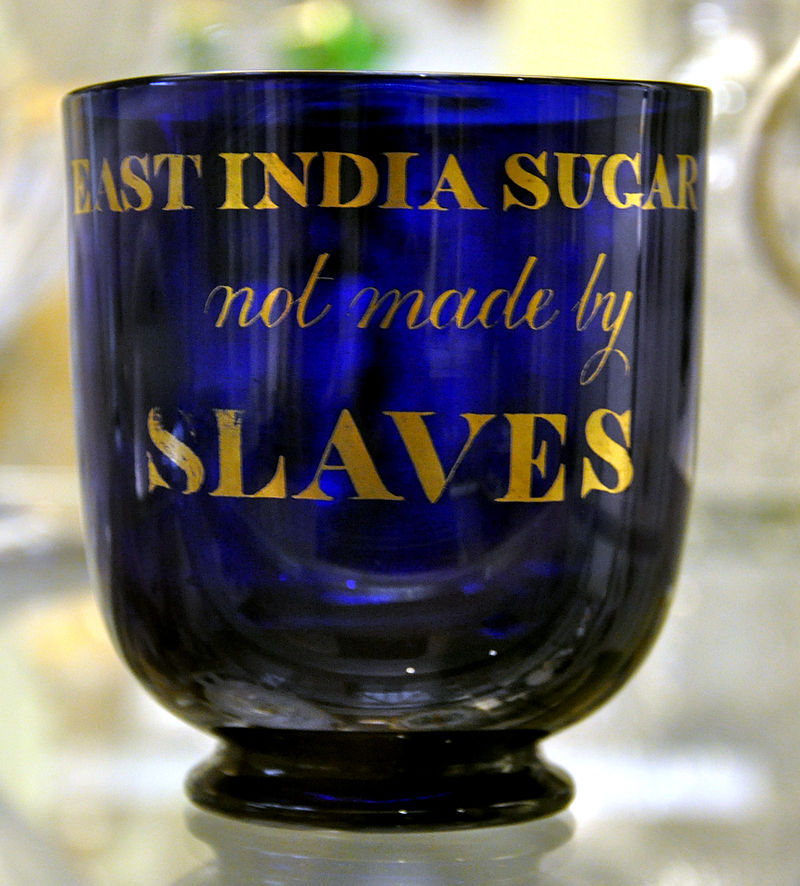
Over the past couple of weeks people across the world have taken to the streets in protest against the death of an unarmed innocent black man named George Floyd. This is not a new phenomenon, and unfortunately since the Black Lives Matter movement began in 2012 following the killing of Trayvon Martin, countless protests have taken place across the world against systemic racism and the danger it poses to the black community. Racism is not a new concept, but for the first time in history social media and smartphones mean that more of it is getting filmed and the struggle is more visible than ever before. Modern racism has its roots in the four centuries of mistreatment since the first African slaves were captured and brought to the West Indies and America by European colonisers. In his second inaugural address to the nation US President Abraham Lincoln criticised the slave trade which propped up the cotton and sugar industries in the Americas, referring to them as ‘original sin’, a stain that lay over the nation. During the famous Gettysburg address in 1863 Lincoln and his supporters celebrated ‘a new birth of freedom’ for all Americans which would come from the end of the America Civil War and the abolition of slavery – but now, 157 years later, inequality remains.
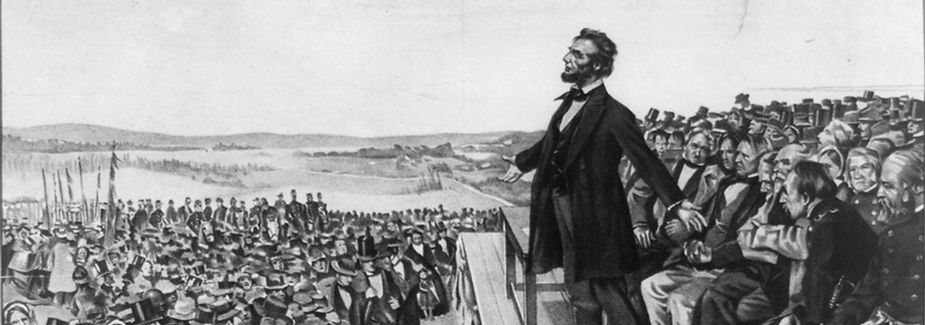
Lincoln’s famous Gettysbury address
For a very long time the Irish have placed a certain amount of pride on the fact that whatever our ancestors might have done, there was no slave trade in Ireland. Daniel O’Connell in particular was vocal about the history of oppression in Ireland and the tangible links we bore to black enslaved Americans – even introducing famous orator and abolitionist Frederick Douglass as ‘the black O’Connell of the United States’. This long-held belief though, as we understand it today, is grossly untrue. Many Irish men and women profited off the back of the Atlantic slave trade, managed slave-run plantations and actively participated in the enslavement of African people.
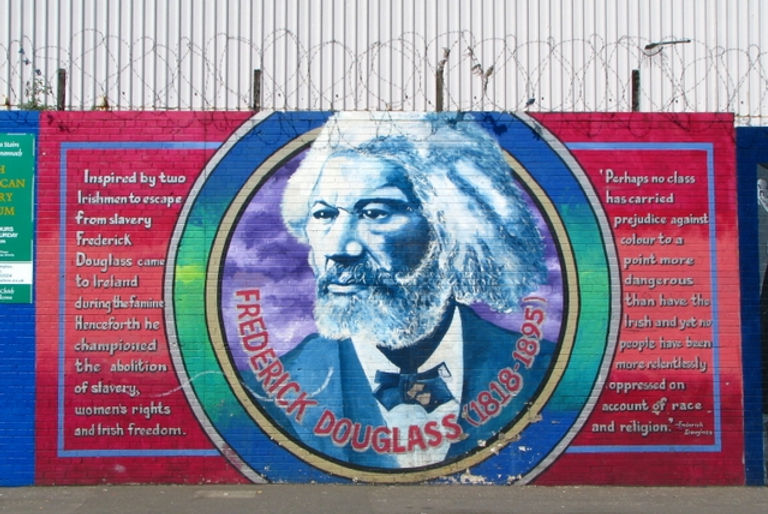
A mural of Frederick Douglass on the Falls Road Belfast. Douglass was an escaped slave whose story resonated with the Irish of the 19th century.
Slavery began in the British Isles in the seventeenth century under Charles II. During this period in European history, sugar was experiencing a major boom in trade and it soon became clear that sugar was as valuable as gold in the right circumstances. Unfortunately it also became clear that because of the labour-intensive farming practices necessary for sugar it could prove difficult to turn a profit. To fix this issue the Royal Africa Company (RAC) was established with the intention of taking slaves to western sugar plantations. These slaves were branded in the centre of their chests with the company logo to prevent them escaping and in order to assuage any guilt they might have felt these early slavers told themselves that the captured men and women were prisoners of war. In Ireland we were not permitted to set up a rival company or an East India company but this did not stop Irish involvement. Many went to England to seek their fortune on the slave-ships and at home some smugglers got involved in the trade. Here in Waterford there is a strand which was often used for smuggling known locally as ‘Trá na mná gorm‘ (beach of the blue women – blue because black skin referred to the devil and women because most African slaves would have been wearing kaftans which would make them look feminine from a distance) which has long been thought to be a reference to smuggled slaves being docked there while they were moved to the west coast to board another ship to the Caribbean.

The Strand at Creaden Head where smugglers may have docked with enslaved Africans.
Limerick historian Liam Hogan has spent much of his career attempting to challenge the long-held notion of what is known as the ‘Irish Slave Myth’, the idea that the Irish were subjected to slavery as much as Africans were. While it is true that many Irish people were sold into indentured servitude during the seventeenth and eighteenth centuries. There are key differences between indentured servitude and slavery, for one, slavery is a lifetime bond, a total removal of one’s rights outside of their existence as the property of another human being while indentured servitude was generally reserved for Catholics and was only for a limited time (usually five to seven years). For the most part, Irish people chose this fate though some were certainly sold into servitude against their will and it is difficult to assess how many might have ‘chosen’ it without feeling as though they had no other option. They were always freed though, and that is the key difference.
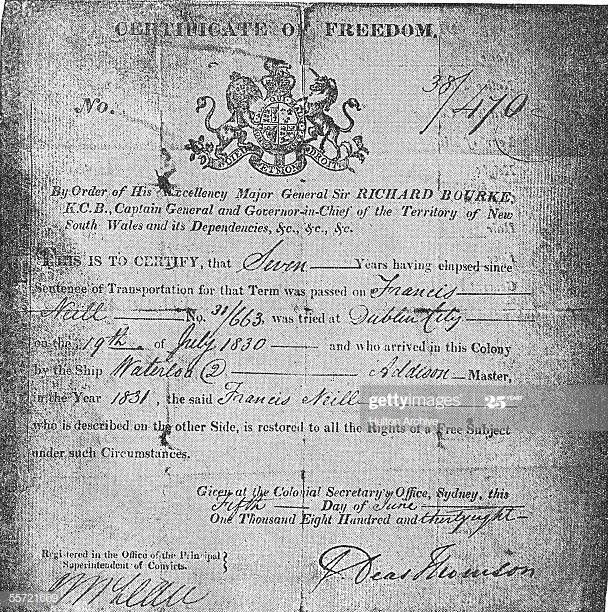
A certificate of freedom issued to an Irish indentured servant in Australia.
One of the most prolific Irish slavers was David Tuohy, a native of Tralee, Co. Kerry who moved permanently to Liverpool in 1771 after some years of travelling back and forth. Tuohy personally captained four slave voyages before 1772, a triangular trip which involved sailing from Liverpool port south to Africa to steal men, women and children from their homes and then sailing on to the Americas where these imprisoned people were sold. Conditions were appalling on these cargo ships with passengers packed in so tightly they were practically on top of one another while chained in place. Disease abounded, particularly dysentery, scurvy and various fevers. The heat was almost unbearable and water supplies were at a minimum which meant that many did not survive the passage west and their bodies were simply thrown overboard. Many others threw themselves overboard rather than face life on the plantations and drowned in the ocean. After captaining these voyages Tuohy settled in Liverpool and became a merchant, though one of his products was slaves and he became the part owner of ten slave ships. He sent his ships to the Windward, Ivory and Gold coasts, the Bight of Benin, and especially Angola and then sold the kidnapped people in Jamaica, Barbados, St. Kitts, Antigua, Dominica and Grenada.
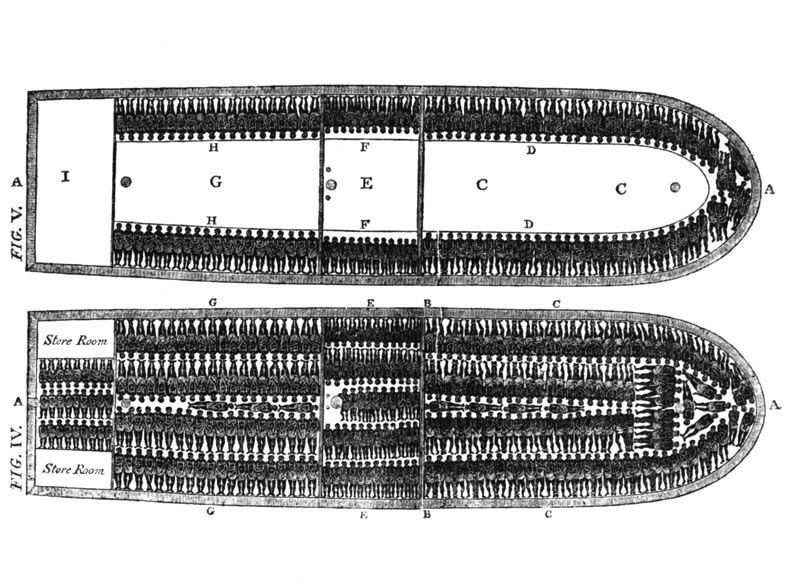
A diagram showing how slave ships were packed with their ‘cargo’ to ensure that no space was wasted
Tuohy though is just one example. While there are certainly many Irish people who were directly involved in the trade, it was far more common for them to have a secondary role, particularly in providing provisions. In most large towns and cities in Ireland the Protestant Ascendancy and Catholic elite controlled most of the trade, with the Catholic middle class taking over as the eighteenth century advanced and butter, beef, pork and leather were huge industries in Ireland. These were very cheaply made here and could be sold to plantations to feed the masters and overseers for a massive profit. The Waterford triangular trade to Newfoundland before the West Indies almost certainly provided the salt cod which became the staple food of enslaved populations and in exchange for these products Irish ships purchased slave-farmed sugar by the tonne, taking it back home to sweeten their tea. Belfast made shoes for enslaved people and across Ireland tenants were evicted from their land to make more room for the cattle who would produce the butter and beef sent to support these plantations.
Another Irishman with links to the slave trade is James Jackson who was born in Ballybay in 1782. He was involved in the Society of the United Irishmen which aimed to unite Irish people of all religions and establish an independent Ireland. He later emigrated to America, settling in Alabama where he became active in state politics and in 1830 he became President of the Alabama Senate. He prospered and acquired the Forks of Cyprus, a large cotton plantation with hundreds of African American slaves. One of the many children that James fathered with his slaves was named ‘Queen’. Her mother’s name is not known. Queen’s grandson was the renowned American writer Alex Haley, the author of Roots. His novel Queen: The Story of an American Family was inspired in part by his grandmother’s early life as a slave and how she began to realise that her owner, James Jackson of Ballybay, was also her father.
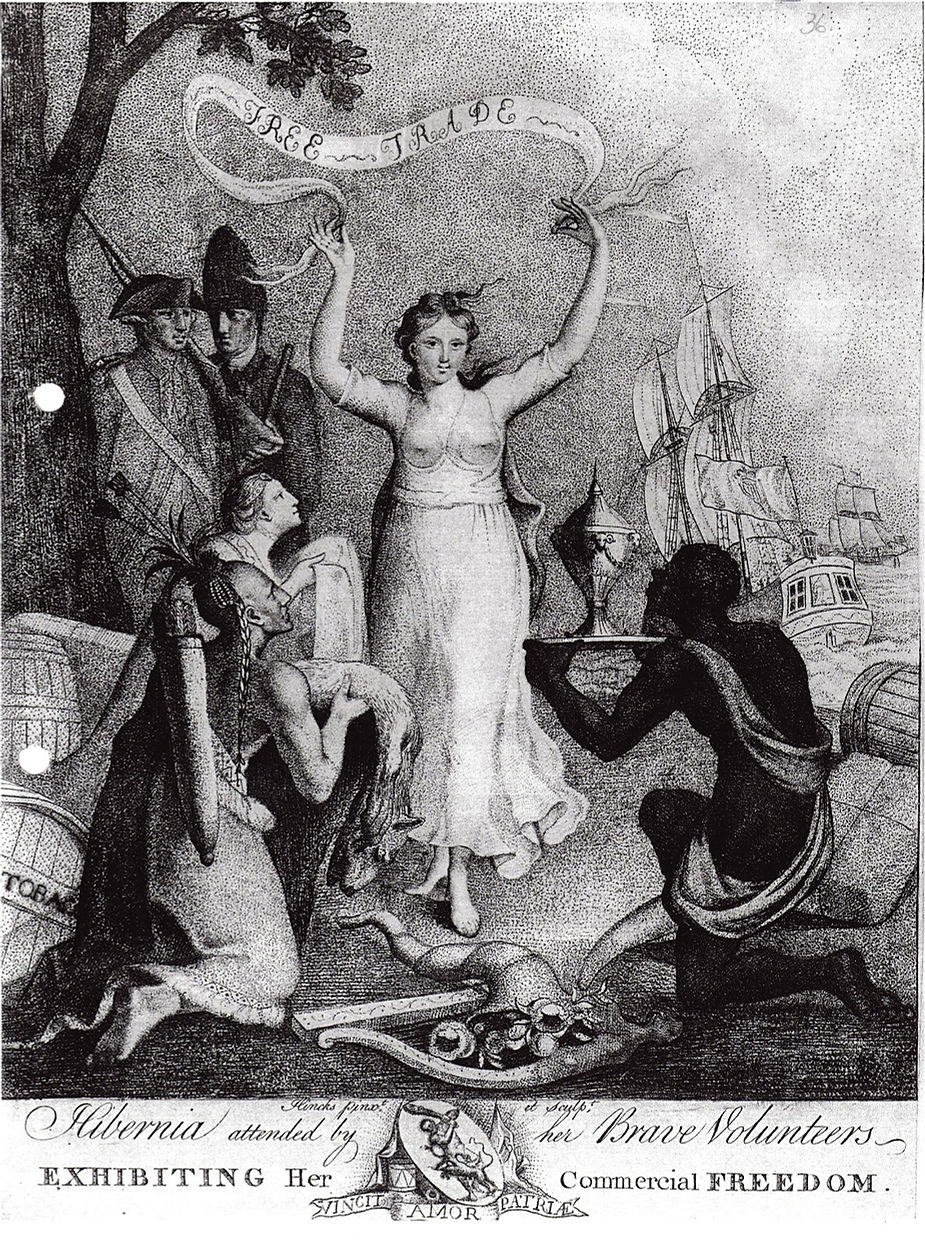
A 1780 print of Hibernia supporting free trade while a black slave offers her a symbol of the riches of Africa. Source: History Ireland
This is not to say that all Irish people were content to sit back and accept slavery as a necessary evil, and in fact many were strongly and vocally against it. In the 1790s the Society of Friends, often called Quakers, eliminated slave-owning in their community and began a faith-wide boycott on goods produced with slavery such as sugar and cotton. The movement soon spread and abolitionists sprang up through the British isles calling for an end to this inhumane treatment. Shopkeepers across the British Isles declined to stock sugar, explaining that they would only continue when they had access to a source that was “more unconnected with Slavery, and less polluted with Human Blood“. At its height, the movement had 400,000 supporters boycotting slave-produced goods in Britain alone, and while support waned, the Quakers of the world continued their protest until the abolition of slavery in America.
Few in Ireland though were more vocal on the subject of slavery than Daniel O’Connell. O’Connell went so far as to refuse to ever set foot in America – even for fundraising – until the stain of slavery had been wiped from the country saying – ‘so long as it is tarnished by slavery, I will never pollute my foot by treading on its shores’. O’Connell’s views on this matter lost him support both at home and abroad, with Americans resenting an Irishman telling them how they ought to behave and some more conservative supporters who had business interests in America feeling uneasy with his anti-slavery speeches. Even within the Young Irelanders there was discontent as some believed O’Connell ought to concern himself solely with domestic matters and leave the struggles of another race to their own countrymen – but O’Connell remained undeterred. In 1829 he declared that ‘of all men living, an American citizen, who is the owner of slaves, is the most despicable’.
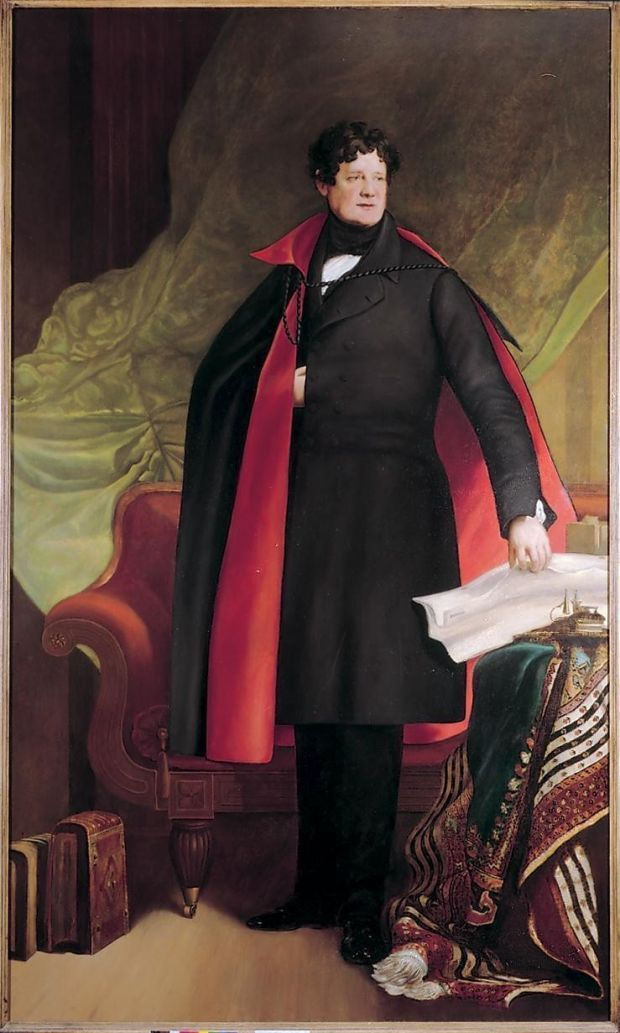
When the British government finally outlawed slavery in the colonies in 1834 they agreed to pay £20 million in reparations to slave-owners for the loss of their property. This move outraged O’Connell who stated that the individuals receiving this payment should be named publicly. Almost 100 of the claimants were Irish with wealthy Dublin banking family the Diggs La Touches receiving £7000 for their 396 slaves on their Jamaican plantation. The La Touches had 500 slaves in 1818 but were clearly not ‘good’ slave-owners as deaths were reported among them by way of ‘eating dirt’ either due to malnutrition or an effort to end their suffering.
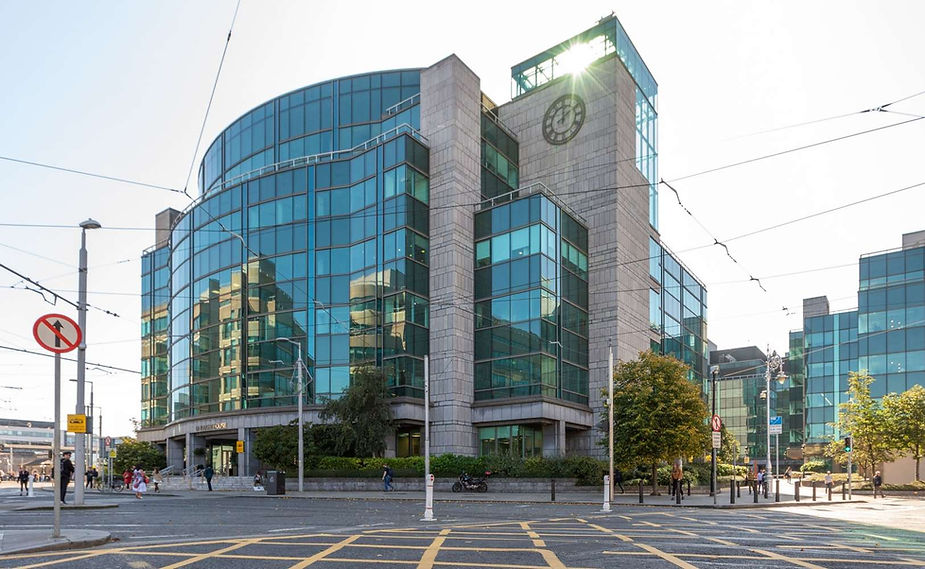
La Touche House in Dublin was named for the family
Sugar was not the only commodity with deep connections to slave labour either, tea and coffee both directly and indirectly contributed to suffering during this period. Due to the fact that coffee became most popular sweetened, as well as the fact that the labour was difficult, the coffee industry developed ties with the slave trade. Slaves were used in coffee-production in Yemen and on the island of Reunion the French kept at least 10,000 slaves for processing coffee beans. By the latter half of the eighteenth century coffee production had equalled (and in some areas even surpassed) the sugar industry in many places in terms of value and profit and this was largely due to increased dependence on slave labour. Debates in parliament in the 1840s reinforced the idea that Ireland would quite happily support foreign industries, but not the slave trade – from Brazil for example Ireland imported several shipments of coffee every year but Brazilian sugar was banned on account of the slave labour they utilised. Unlike coffee, tea has never been directly linked with slavery though the European taste for sweetened tea did contribute heavily to the slavery industry during the eighteenth century.

A sugar bowl made during the Quaker boycott of the late eighteenth century. Source: Wikipedia
The stain of original sin which Abraham Lincoln referenced all those years ago has not been completely wiped from the modern world and even here the legacy of this brutality scars the landscape with monuments and homes of those who directly profited from the slave trade still standing on our streets. It is not unheard of in Ireland when the subject of racism in America comes up to hear someone utter the phrase ‘Well, the Irish were slaves too’ and while it is indisputable the the Irish have suffered historically and feel a certain kinship with the Black American experience, a statement like this is offensive at best and dangerous at worst. While the Irish were sent to the Caribbean by the thousands as indentured servants, to compare seven years of servitude to a lifetime spent as little more than chattel seriously undermines the history of black struggle. Racism is not a monster of the past and today around 40 million people are enslaved worldwide from individuals in forced marriages to child labourers that prop up the modern chocolate industry. We cannot rewrite history or begin to make amends for it, but we can confront our past and the role our ancestors played, we can use this knowledge and educate ourselves, and through that we can change the future.
Please Note:
When we posted this blog on Tuesday the 9th of June, we anticipated a certain degree of controversy regarding its contents, particularly because of the fact that it directly challenges the so-called ‘Irish Slave Myth’. The vast majority of comments we received were positive, however, through moderating our comment section on social media it became apparent that the same criticisms were cropping up again and again, namely: These people who participated were not Irish, they were British/ Protestant/ Anglo-Irish people, on the whole, Irish people did not benefit from the transatlantic slave trade and finally, that we were disregarding the fact that we as a nation had endured unspeakable oppression and had been ‘slaves’ ourselves. Taking these criticisms on board, I would like very much to address them now.
The latter of these comments requires the clearest distinction, the idea of the Irish that were sent to the West Indies being ‘slaves’ who were treated sometimes worse than the black slaves in those same countries. It is certainly true that a large number of Irish people were sent west against their will under Cromwell’s rule but these people were indentured servants rather than slaves. They served a limited sentence of 5-7 years, rather like convicts sent to Australia and after this they were free, either to make their way home (which was admittedly almost impossible given the cost of a passage back east) or to make their own way on the island. As a result, many of these former indentured servants in time became extremely wealthy and often slave owners themselves. Some were left with no choice but to sign the contract in order to afford the passage to the new world where they could make a better life for themselves – more signed it completely willingly. ‘Slave’ is a legal term born during this period to describe a person who had been stripped of their personhood and reduced to a piece of property. They would spend their entire lives as the possession of another human being, were subject to their whims and punishments, their children would be slaves and their grandchildren would be slaves. It was a hereditary sentence which you could only escape with the benevolence of your master, who literally held your life in their hands, or through the abolition of slavery (1834 in Britain, 1865 in the USA). Indentured servitude is coerced-labour, which yes, can arguably be referred to as a form of slavery – but crucially, it was not. White labourers could escape and hide among the general population with a degree of safety, whereas even a free black man could be captured and sold into slavery as happened to Solomon Northup in 1841.
The other criticism, that these people were not Irish but British, is more complicated to address. Nationality and cultural identity are immensely complicated issues and often this relationship is intensely personal . To suggest the Anglo-Irish of eighteenth-century Ireland were solely British is to strip them of the unique identity which they felt best described them. What we have to remember when speaking about the Irish during this time period is that Ireland was a country which had been subject to countless mass-settlements and thus the Irish identity was extremely complicated even before you take into account that the Irish of this period were indeed Irish and British at once – Ireland being part of the commonwealth at that time. There is no true ‘native’ Irish, the first settlers arrived on our shores 9000 years ago and found an uninhabited island. After this the Vikings arrived, settled, and within a generation had come to regard themselves as Hiberno-Norse, a new cultural identity which was at once Irish and Viking. Next came the Anglo-Norman armies under Strongbow and Henry II and once again these families settled and began to refer to themselves in new ways which best described their own relationship with their physical and ancestral homes. Subsequent plantations complicated the issue further, as did the advent of the Church of Ireland but one thing we know for sure is that each of these people would have regarded themselves as something unique which made sense to them. Many members of the Anglo-Irish Protestant Ascendancy – a term which by the way is designed both to distinguish and crucially to ‘other’ this group to explain deeds which harmed Catholics over many generations – were proud Irish patriots, men like Wolfe Tone, Henry Grattan, Robert Emmet and Charles Stuart Parnell. The La Touche family who I mentioned in the blog were originally French Huguenots that arrived here to escape persecution in the seventeenth century and remained in this country until the line died out in 1921. Irishness is very important to modern Irish people, particularly given the history of struggle and strife this nation has suffered, but Irishness is about so much more than suffering, and one does not have to be from a long line of starving tenant farmers to call themselves Irish. Today there are people with heritage from all over the world who are, crucially, Irish. To claim that these people, who were born in Ireland, called this country their home (even part of the time) and specifically listed their addresses in Ireland cannot be considered Irish by modern standards is to erase the long and complex history of national identity.
Finally came the assertion that the general population did not profit from this trade, only select individuals. We did mention that several prominent Irish people were firmly and vociferously opposed to the slave trade, Daniel O’Connell and the Society of Friends among them, but this does not mean that the Irish economy did not benefit from money that had been tainted by slavery. There were newspaper articles and parliamentary debates right through this period about the concerns raised by the farming methods used by sugar plantations around the world – contemporary culture was very aware of where the sugar, cotton and tobacco they were using was coming from, but these products kept on pouring into the ports of this country. Sugar was bought with the money made from selling goods that were knowingly produced as provisions for slave plantations – butter, beef, pork, leather, all key industries in Ireland and particularly in the South East. For this reason, every merchant who purchased sugar, every sailor who procured it, every shopkeeper that sold it in their stores, every middle to upper class consumer, every confectioner, every tea and coffee house owner, everyone who sold or purchased tobacco, every individual who wore cotton clothes or used slave-produced cotton in their textile houses – every one knowingly and happily benefited from the Transatlantic Slave Trade. The injection of cash into the Irish economy from all of this is evident and is further proof that the Irish participated, profited and benefited from black slavery.
This blog never sought to eradicate the complex history of Ireland’s relationship with indentured servitude, merely to educate people on the fact that history is never black and white. History is written with baggage and emotional bias, which is why topics like this can be frustrating, uncomfortable and even offensive to read – especially for the Irish who have such a complicated relationship with Britain and forced labour themselves. However, our own suffering does not absolve our ancestors of their actions and does not erase the clear documentary evidence of Irish involvement in the Transatlantic Slave Trade.
Further Reading:
The Irish Slave Myth: https://en.wikipedia.org/wiki/Irish_slaves_myth
Nini Rodgers, The Irish and the Atlantic Slave Trade, https://www.historyireland.com/18th-19th-century-history/the-irish-and-the-atlantic-slave-trade/
Daniel O’Connell and Slavery, https://www.historyireland.com/18th-19th-century-history/a-consistent-advocate-of-nigger-emancipationdaniel-oconnell-and-the-campaign-against-slavery/
Liam Hogan, Following the money – Irish slave owners in the time of abolition, https://www.thejournal.ie/readme/irish-slaveowners-compensation-1587899-Jul2014/
The Tuohy Papers at the British Online Archives, https://microform.digital/boa/collections/5/volumes/26/the-tuohy-papers


